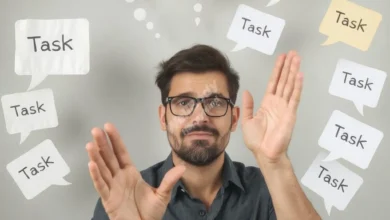The Hidden Cost of Poor Boundaries: A Guide to Better Limits

Have you ever felt drained after helping everyone except yourself? You’re not alone. Many people struggle with setting boundaries every day. Poor boundaries can affect your entire life. They impact your relationships, work, and mental health. This guide will help you understand and improve your boundary-setting skills.
What Are Personal Boundaries?

Personal boundaries are like invisible lines that protect our wellbeing. They show others how to treat us. These limits help us stay mentally and emotionally healthy. Think of boundaries as your personal instruction manual for relationships.
There are three main types of boundaries:
- Emotional Boundaries: They protect your feelings and energy
- Physical Boundaries: They guard your personal space and body
- Digital Boundaries: They manage your online presence and availability
Many people find it hard to set proper boundaries. Here’s why this happens:
- Fear of rejection or conflict
- Past experiences of criticism
- Cultural or family expectations
- Low self-esteem
- People-pleasing habits
Signs You Might Have Weak Boundaries
Your body and mind will tell you when your boundaries need work. Pay attention to these warning signals:
- You feel overwhelmed by others’ problems
- Saying “no” makes you feel guilty
- You often feel resentful or angry
- Your schedule is packed with others’ requests
- You rarely have time for self-care
The Social Impact of Poor Boundaries
The consequences of poor boundaries reach far into our social lives. Let’s look at how they affect different relationships.
Family Relationships:
Sarah’s story shows us a common problem. She answers every family call. She drops everything to help relatives. Now she’s exhausted. Her own life is on hold. Setting limits helped Sarah create healthier family bonds.
Friendship Dynamics:
Good friends respect each other’s limits. When you can’t set boundaries, friendships suffer. You might feel used. Your friends might not know your true feelings. Healthy boundary setting relationships start with honest communication.
Professional Impact:
Here’s how boundaries affect your work life:
| Healthy Boundaries at Work | Poor Boundaries at Work |
|---|---|
| Clear work hours | Always available |
| Taking breaks | Working through lunch |
| Saying no to extra tasks | Taking on too much |
| Respected personal time | Answering calls after hours |
The Hidden Emotional Toll

Weak boundaries can hurt you in silent ways. Your mental health pays a heavy price. Research shows that poor boundaries increase stress by 40%. Let’s explore how this affects your daily life.
The Impact on Your Mental Health:
Your emotions need protection just like your body. Poor boundaries drain your emotional energy. Here’s what mental health experts often see:
- Increased Anxiety: Constant worry about others’ needs
- Deep Fatigue: Your energy gets depleted faster
- Regular Stress: Your mind never truly rests
- Low Self-Worth: You value others more than yourself
Dr. Sarah Chen, a leading psychologist, explains: “Most of my clients feel immediate relief after setting boundaries. Their stress levels drop within weeks.”
Common Challenges You Might Face
The social effects of weak boundaries show up in many ways. They create patterns that hurt your relationships. Here’s what these patterns look like in real life.
The People-Pleasing Trap:
John always said yes to extra work projects. His own tasks fell behind. His health suffered. He learned to value his time through boundary setting. Now his work quality has improved.
Common signs of people-pleasing include:
- Taking on too many responsibilities
- Apologizing for things that aren’t your fault
- Changing plans to accommodate others
- Hiding your true feelings
- Putting everyone else first
The Struggle with Saying No:
Many people find it hard to say no. Here’s why it matters:
- Your time is valuable
- Your energy has limits
- Your needs are important
- Your choices affect your wellbeing
The Cost to Your Identity
Poor boundaries can make you lose yourself. Your true personality might fade away. You might forget what you really want in life.
Here’s how this happens:
- You adopt others’ opinions too easily
- Your own dreams take a back seat
- Your values get compromised
- Your interests get forgotten
Real Stories of Identity Loss:
Maria’s experience shows this clearly. She always matched her friends’ interests. She watched their shows. She liked their music. She forgot her own preferences. Setting boundaries helped her rediscover herself.
Signs Your Identity Is Fading:
- You often say “I don’t mind” when asked for preferences
- Your opinions change based on who you’re with
- You rarely pursue your own interests
- You feel unsure about your true desires
How Society Shapes Our Boundaries

Our culture affects how we set boundaries. Different societies have different expectations. Modern life brings new boundary challenges. Let’s explore these important factors.
Cultural Influences on Boundaries:
Every culture views boundaries differently. Some value group harmony over personal space. Others focus on individual needs. Here’s what research tells us:
- 65% of people struggle with boundaries due to cultural pressure
- Family traditions often override personal limits
- Social media creates new boundary challenges
- Workplace cultures vary greatly by region
Gender and Boundary Setting:
Society often has different rules for different genders. These expectations can limit personal growth. Consider these patterns:
- Women face pressure to be always helpful
- Men struggle to show emotional boundaries
- Non-binary individuals navigate complex expectations
- Traditional roles can restrict boundary setting
Digital Age Challenges
Modern technology brings new boundary problems. Work emails reach us at all hours. Social media demands constant attention. Here’s how to handle these challenges:
Common Digital Boundary Issues:
- 24/7 work expectations
- Constant message notifications
- Social media pressure
- Online privacy concerns
Breaking Free: Your First Steps
Change starts with small actions. Here’s your path to better boundaries:
Step 1: Recognize Your Patterns
- Notice when you feel overwhelmed
- Track your yes/no responses
- Write down boundary violations
- Identify your triggers
Step 2: Start Small
- Take short breaks
- Delay your responses
- Practice saying “I’ll think about it”
- Set one small boundary each week
Step 3: Handle Pushback
People might resist your new boundaries. Stay strong but kind. Use these strategies:
- Remain calm and firm
- Explain your needs clearly
- Accept that some won’t understand
- Keep your boundaries anyway
The Rewards of Healthy Boundaries

Setting good boundaries brings many benefits. Your life can improve in amazing ways. Here’s what you’ll notice:
Better Relationships:
- More honest connections
- Deeper trust
- Mutual respect
- Less drama
Improved Mental Health:
- Lower stress levels
- Better sleep
- More energy
- Clearer thinking
Enhanced Self-Respect:
- Stronger self-confidence
- Better decision-making
- More authentic living
- Increased happiness
Your Journey to Better Boundaries Starts Now
The path to healthy boundary setting relationships takes time. Every small step matters. Your future self will thank you for starting today.
Key Takeaways:
- Boundaries protect your wellbeing
- Small changes create big results
- Everyone deserves personal limits
- Better boundaries mean better relationships
Frequently Asked Questions
Q: How do I set boundaries without feeling guilty?
Start with small steps. Remember that boundaries are healthy. Your needs matter too. Practice makes this easier.
Q: What if people get angry about my boundaries?
Some people might resist change. Stay calm but firm. Good relationships will adjust. Others might need time.
Q: How long until boundary setting feels natural?
Most people see changes within a few weeks. Your confidence grows with practice. Each small win helps.
Q: Can I have different boundaries with different people?
Yes! Your boundaries can be flexible. They should match each relationship. Trust your judgment.
Your Boundary-Setting Toolkit
Download our free worksheet to start your journey:
The Worksheet Includes:
- Boundary assessment quiz
- Weekly planning template
- Response scripts
- Progress tracker
Daily Practices for Success:
Morning Check-in:
- Review your goals
- Plan your responses
- Set daily limits
Evening Reflection:
- Note your successes
- Plan improvements
- Celebrate progress
Final Thoughts and Action Steps
The consequences of poor boundaries can hurt your life. But change is possible. Start your journey today.
Take these first steps:
- Download the worksheet
- Pick one boundary to practice
- Start with someone safe
- Notice how you feel
Remember this truth: Strong boundaries create stronger relationships.
Your Next Steps

Begin your boundary-setting practice today:
- Save this guide
- Share it with friends
- Join our community
- Start your journey



